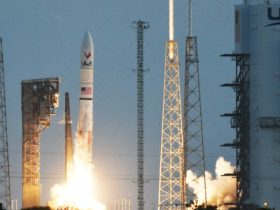Air Force and Space Force leaders this week continued their call for more resources to fund key space capabilities, naming domain awareness and counterspace systems as their top priorities in fiscal 2026.
The Space Force and the rest of the military services recently submitted their fiscal 2026 funding plans to Pentagon leadership, and the Defense Department will soon begin deliberations on how to spend the more than $800 billion Congress allocates for national security each year.
Speaking with reporters Tuesday at the Air Force Association’s Air, Space and Cyber Conference, Chief of Space Operations Gen. Chance Saltzman said that while it’s too early in the budget process to know how the service’s priorities will match up against other DOD demands, awareness of the space environment and the means to protect and fight back against adversary threats are critical needs for the Space Force.
“We have to understand what’s going on in the domain to effectively employ counterspace capabilities,” he said.
Established in 2019, the Space Force is the newest military service, and its $30 billion budget is the smallest in the department. Air Force Secretary Frank Kendall has said the demand for space capabilities is outpacing its limited resources and has advocated for the Space Force’s budget to double or triple in the coming years.
“The Space Force is beginning a transformation that must be executed quickly and at scale,” Kendall said during a Monday speech at the conference. “That takes resources.”
In the near-term, more funding for the service could come through a congressional budget increase, though based on the FY25 funding levels proposed by appropriators in both chambers, a move in the opposite direction appears more likely.
The House Appropriations Committee’s policy bill would, if passed, cut about $900 million from the Space Force’s request. Senate funding legislation would slash around $1 billion.
The Pentagon could also draw space funding from the Air Force or the other services’ budgets, making trade-offs to fund key missions.
Saltzman said he’s not sure how the money will materialize.
“A new mission requires new resources and new funding, so I don’t have a good answer for what those sources are,” he said. “But you know, we’ve got $800 billion-plus, and we’re going to have to make the decisions about where we need to invest to make sure we can do all the missions effectively.”
The Space Force has been working for the past several years to determine the right mix of satellites and other systems that will be needed to adapt to new threats in orbit. Led by the Space Warfighting Analysis Center, the service has conducted mission-by-mission reviews that, when stitched together, lay out a vision for its ideal force structure over the next 10 to 15 years.
Counterspace capabilities are a key part of that vision, as is space domain awareness, missile warning and tracking and space-based intelligence, surveillance and reconnaissance.
The Space Force views the capabilities it provides as enablers for the other military services, providing key support for maritime, land and air missions. However, in some cases, the other branches are developing their own space capabilities.
The Army in January rolled out a plan to up its investment in space capabilities that support ground operations. Dubbed the Army Space Vision, it emphasizes the need for systems that can interdict, or disrupt, enemy ISR capabilities.
Asked by reporters whether the Space Force is concerned about potential competition from the Army for personnel or funding, Saltzman said he takes a nuanced view of the issue.
“I’m still not of the mindset that this is a zero-sum game and everything has to come out of somebody else’s budget,” he said. “The Department of Defense budget ebbs and flows, and you have to understand where you are in that process.”
It’s not a surprise that the other services want to invest in space systems, Saltzman said, but it’s up to the department to determine whether it makes sense to spread space funding across several branches or focus it within the Space Force’s budget.
“We just have to find the smart way to do it,” he said. “If there’s something that they can do that we won’t do, great. If there’s something we can do that they don’t need to do anymore, great. We can share resources.”
Courtney Albon is C4ISRNET’s space and emerging technology reporter. She has covered the U.S. military since 2012, with a focus on the Air Force and Space Force. She has reported on some of the Defense Department’s most significant acquisition, budget and policy challenges.
Read the full article here








Leave a Reply